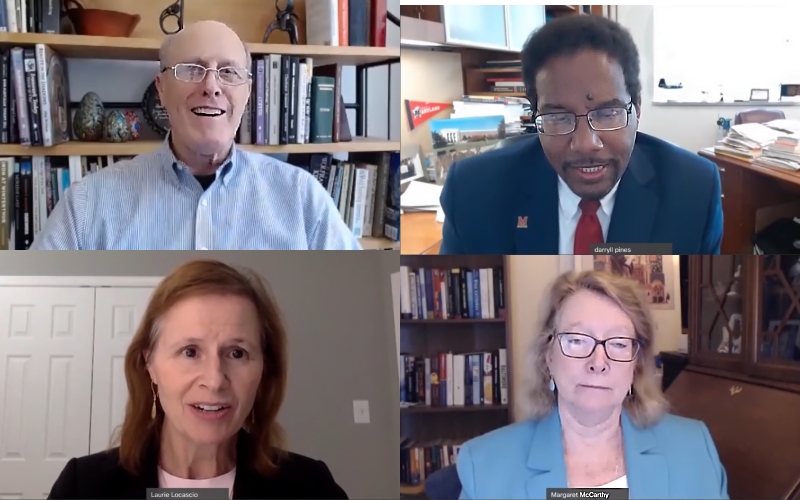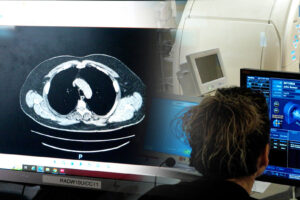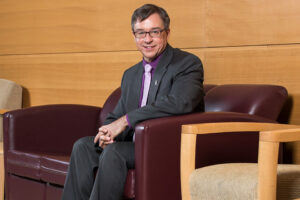Town Hall Mulls Restarting Research At UMB
Published 5/27/20 on UMB News
Education has always gone hand in hand with research at the University of Maryland. Among what it called the “many benefits” the General Assembly was hoping to promulgate when it established the College of Medicine of Maryland – even if it didn’t use these words – were improvements to the lives of Marylanders, improvements to the human condition.
Two centuries later, the College of Medicine of Maryland has grown into an entire University System of Maryland (USM), with 12 institutions across the state. At the University of Maryland, Baltimore (UMB), seven schools and more than 40 research centers and institutes focus on a dizzying array of topics, including chronic pain, regulatory science, health outcomes, health and homeland security, human virology, genome sciences, and much more. And recent years have seen the growth of many new avenues of research collaboration between UMB and the University of Maryland, College Park (UMCP) under the aegis of the University of Maryland Strategic Partnership: MPowering the State.

But the greatest part of all of that work came to a halt March 23, when the threat of COVID-19 forced the curtailment of all activities not critical to maintaining animals, unique reagents and cell lines, and essential equipment. Left standing was research related to COVID-19, including trials of four variants of Pfizer’s mRNA vaccine candidate, and studies with drug therapies, notably hydroxychloroquine and remdesivir.
Now, two months later, UMB Interim President Bruce E. Jarrell, MD, FACS, has announced that the University’s COVID-19 Research Advisory Task Force has developed a phased plan for nonclinical laboratory-based research at UMB. Phase 0 – now in effect – involves planning and preparation for the “gradual and deliberate reopening of on-campus research activities with a proposed start date sometime in June.” The next phase, Phase 1, envisions research restarting at approximately 25 percent capacity with some restrictions.
On May 26, Jarrell was joined by Darryll Pines, PhD, UMCP president-designate; and the leaders of the UMB Recovery Task Force’s Research Advisory Task Force, Laurie Locascio, PhD, Vice President of Research for both universities, and Margaret McCarthy, PhD, the James and Carolyn Frenkil Endowed Dean’s Professor, professor and chair of the Department of Pharmacology, at the University of Maryland School of Medicine, for a virtual town hall discussion about restarting research at UMB and throughout the USM.
Locascio and McCarthy explained the planning now underway in Phase 0, and provided more details about enhanced safety procedures to be implemented as research begins to restart under Phase 1. “We will require the use of masks at all times in the common spaces, and we are limiting hours to 7 a.m. to 7 p.m.,” Locascio said. “We want as few people as possible on campus during Phase 1.”
“We came to the consensus that the best approach was to implement a vigorous screening procedure,” McCarthy added. She explained that the screening will include the use of a modified version of software now used by the University of Maryland Medical Center, called Red Cap.
Red Cap provides daily screening, with notification to supervisors about the results. The program prompts the employee to take their own temperature, or if that’s not possible, to disclose any other possible COVID-19 symptoms, such as feeling feverish, or recent loss of taste or smell.
“If you register 100 degrees or greater,” McCarthy explained, “you will then be sent instructions to immediately contact the COVID hotline where you will speak in person with a nurse practitioner who will ask you further, more detailed questions. That nurse will then decide whether you will be recommended for testing.”
Pines presented additional guidance for restarting research at all USM institutions. “We are really grounded by CDC guidance, but we also want to be able to look at some advances in technology, some mobile applications, and maybe have a higher protocol for volunteer opportunities to evaluate lots of things while we’re doing this restart of research,” he said.
One possibility, he told the audience, would be to solicit volunteer lab groups to participate in higher levels of testing as a way of evaluating the usefulness of different testing and screening protocols. “It’s an opporunity for us to understand how folks will be tested if we decide to do that going forward in a deeper sense in the fall,” he said.
Audience questions ran the gamut from renewed research using human subjects, support for purchasing and distributing personal protection equipment, and of course, the timing of the implementation of Phase 1, and with it the resumption of some research.
“When you walk into your lab, other things have to be ready other than your lab and lab personnel,” Jarrell advised one questioner. “The lab has to be properly cleaned and facilities management will be very involved to make sure your lab has been cleaned properly. EHS will be very involved in terms of making sure things are ready to go. Our intention is to make it safe and we’ll go back to the labs as soon as we’re satisfied that all those things are in place, which I hope would be sooner rather than later.”



